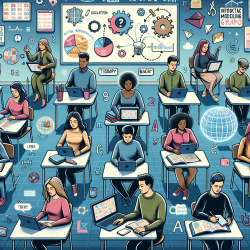Using Technology to Teach Math to Students with Disabilities: Insights from Research

Are you looking to improve your skills in teaching mathematics to students with disabilities? Recent research published in the International Journal of STEM Education offers valuable insights on this topic. The study, titled "A content analysis of research on technology use for teaching mathematics to students with disabilities: word networks and topic modeling," delves into the evolution of educational technology and its applications in special education over the past four decades.
The Evolution of Technology in Math Education
The study conducted a content analysis of 488 research articles published from 1980 to 2021. It revealed significant trends in the use of technology for teaching mathematics to students with disabilities. Here are some key findings:
- 1980s and 1990s: The focus was primarily on computer-assisted instruction (CAI) and software, with terms like "computer" and "learning disabled" frequently appearing in research.
- 2000s: There was a shift towards using calculators and testing tools, with "learning disability" becoming a central term.
- 2010s to 2021: The focus expanded to include visual-based technologies like virtual manipulatives, augmented reality, and apps, alongside traditional methods like word problem-solving instruction.
Key Research Topics and Their Evolution
The study identified 15 distinct research topics using structural topic modeling. Here are some notable ones:
- Computer-Assisted Instruction (CAI): This has been a consistent area of focus, although its prevalence has decreased over time.
- Visual-Based Technology: The use of virtual manipulatives and augmented reality has seen a significant increase, especially after 2010.
- Word Problem-Solving Instruction: This topic has remained relevant, with an increasing focus on schema-based and video-based instruction.
- Apps and Auditory Support: These technologies have gradually gained attention, reflecting the rise of mobile and assistive technologies.
Practical Implications for Educators
Based on these findings, educators can consider the following strategies to enhance their teaching practices:
- Integrate Visual-Based Technologies: Tools like virtual manipulatives and augmented reality can make abstract math concepts more tangible for students with disabilities.
- Focus on Word Problem-Solving: Employ schema-based and video-based instruction to help students develop problem-solving skills.
- Leverage Apps and Auditory Support: Utilize mobile apps and auditory tools to provide personalized and accessible learning experiences.
Encouraging Further Research
While the study provides valuable insights, it also highlights the need for ongoing research to explore new technologies and their applications in special education. Educators are encouraged to stay updated with the latest research and continuously adapt their teaching methods to meet the evolving needs of their students.To read the original research paper, please follow this link:
A content analysis of research on technology use for teaching mathematics to students with disabilities: word networks and topic modeling.
Citation: Shin, M., Ok, M. W., Choo, S., Hossain, G., Bryant, D. P., & Kang, E. (2023). A content analysis of research on technology use for teaching mathematics to students with disabilities: word networks and topic modeling. International Journal of STEM Education. https://www.ncbi.nlm.nih.gov/pmc/articles/PMC10039814/?report=classic










